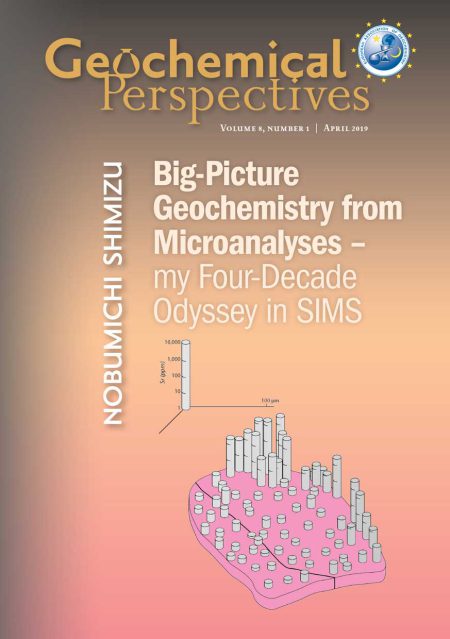
Big Picture Geochemistry from Microanalyses – My Four-Decade Odyssey in SIMS
by Nobumichi Shimizu1doi: 10.7185/geochempersp.8.1 | Volume 8, Number 1 (pages 1-104)
Abstract
Secondary Ion Mass Spectrometry (SIMS) is now a well established analytical technique in geochemistry. Its developmental history goes back to the 1970s. Here, I tell the story of how I got involved in its applications to geochemistry in 1974 at the Institut de Physique du Globe in Paris (IPGP) with the Cameca IMS 300 instrument and my ensuing struggles with theories of secondary ion formation processes and the eventual development of the energy filtering approach as an effective method for suppressing molecular ion interferences in silicate minerals and glasses.
The geochemical applications of the techniques that I developed with my colleagues at IPGP, Massachusetts Institute of Technology (MIT), and Woods Hole Oceanographic Institution (WHOI) are summarised in four different categories: (1) trace element zoning of phenocrysts and the kinetics of magmatic crystallisation processes, (2) trace element abundance patterns and geochemical processes in the mantle, (3) use of trace element abundances in magmatic processes in the mid-ocean ridge system, and (4) use of Sr/Ca ratios in biogenic carbonates in palaeoceanographic studies.
Trace element zoning patterns observed in phenocrysts reveal that crystal growth in magmas can occur with non-equilibrium partitioning of trace elements at the crystal-melt interface. Trace element zoning patterns in augite phenocrysts from Gough Island also indicate repeated drastic changes in magma composition, suggesting a turbulent dynamic state of magma bodies beneath eruptive centres.
Chondrite normalised rare earth element (REE) patterns measured in clinopyroxenes from mantle rocks (peridotites from the Horoman massif and xenoliths in basalts from both oceanic and continental localities) show strong evidence for melt-rock reactions, indicating that lithospheric peridotites depleted in incompatible elements by melt extraction often show evidence of having been subsequently enriched in these elements through melt-rock reaction. The distribution of Sr in garnet inclusions in peridotitic diamonds from South Africa and Siberia is highly heterogeneous over wide concentration ranges, suggesting growth of inclusion garnets as well as formation of these diamonds, occurred shortly before the diamonds were carried to the surface by kimberlite eruptions.
Rare earth element and other trace element abundance patterns measured in clinopyroxenes in abyssal peridotites clearly indicate that melting and melt extraction processes beneath mid-ocean ridges is akin to fractional melting by which small degree melt fractions are progressively extracted from residues as the mantle decompresses and only later mixed, sometimes incompletely, to form mid-ocean ridge basalt lavas erupted on the ocean floor. However, meltrock reactions between residual peridotites and upwelling melt fractions could significantly alter trace element abundance patterns of originally residual clinopyroxenes. In situ analyses reveal very large trace element variations occurring on intra-mineral scales, suggesting that precipitation of clinopyroxene also occurred during melt-rock reactions. It is evident that abyssal peridotites contain complex geochemical histories beyond melt extraction via fractional melting.
Sr/Ca variations in coral skeletons (aragonite) reveal strong effects of photosynthesis of symbiont algae in day time growth zones, while those in night time growth zones near centres of calcification record variations of sea surface temperatures (SST) in Porites lutea. In Astrangia poculata, which experience a large temperature range (-2 – 23 °C), non-symbiotic skeletons faithfully record temperature variations, while symbiotic skeletons display ontogenic effects of algal symbionts. Sr/Ca variations in coccolithophores across the Paleocene-Eocene Thermal Maximum (PETM) display different responses of individual species to the sudden greenhouse environment, and the severity of the response also is dependent on the oceanographic conditions of their habitats.

